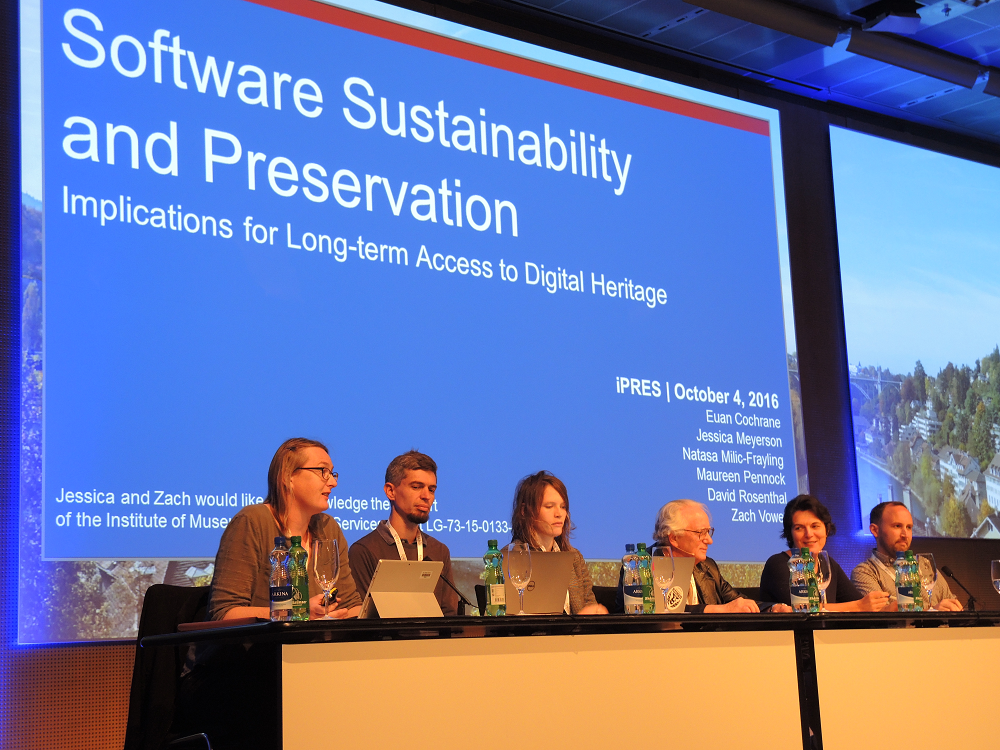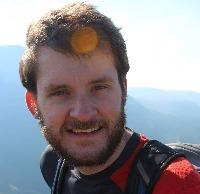
Paul Young has been Digital Archivist at the National Archives for just over a year, dealing with the ingest of Born-Digital records and undertaking file format research for PRONOM.
Paul attended iPRES 2016 with support from the DPC's Leadership Programme. This blog is part of a series produced by scholarship recipients who attended iPRES 2016.
Panel Discussion: Software Sustainability and Preservation: Implications for the Long-Term Access to Digital Heritage

Panel – left to right – Maureen Pennock, Zach Vowell, Jessica Meyerson, David Rosenthal, Natasa Milic-Frayling and Euan Cochrane.
The panel was chaired by Maureen Pennock from the British Library, she started off by asking the audience a series of questions such as who was implementing or planning an emulation program, prompting a scattering of raised hands; however the final question received a more muted response.
No hands raised on "who feels confident that within next few years (emulation) project will be biz a usual #ipres2016
— Sheila Morrissey (@sheilaMorr) October 4, 2016
The panel then introduced themselves and talked about their work on software sustainability over the past year. Zach Vowell from California Polytechnic State University and Jessica Meyerson from University of Texas at Austin described the work they had been doing with the Berkman Klein Centre on legal challenges for preserving legacy software as well as their work with the Software Preservation Network Forum. David Rosenthal from Stanford University Libraries talked about his extensive work and handily wrote it all up in a blog. Natasa Milic-Frayling from the University of Nottingham introduced the work she has been doing as part of UNESCO-PERSIST. Euan Cochrane from Yale University explained his work which he summarised in a recent blog on emulation and potential of Wikidata as a digital preservation knowledgebase.
The panel was then presented with a series of questions which prompted discussion around a collection of themes. One of the main themes was collaboration. Euan expressed an idea of sharing your emulation efforts by making available disk images which you have created, such as a base disk image of Windows 95 with Office 97 installed; people can use this and add additional layers as needed.
The discussion then went into the legal challenges around getting the industry to make end of life software available and whether laws or legal requirements for access to software were needed. Natasa spoke of the work Unesco Persist, which is talking to the digital preservation community to get their requirements and then approaching the industry to negotiate licenses to access software. Natasa argued that one of the most effective strategies will be to try and show companies the benefits of future proofing their software by showing them customers are more likely to purchase products which they know will endure for the long term. However Euan stated that to access all required versions of software there would still be a need to go to ‘dark corners of the Internet’.
Shhhhhhh https://t.co/5BHqwbSjLl
— Paul Wheatley (@prwheatley) October 4, 2016
The cost of software sustainability and emulation was a running theme, David Rosenthal stated that in many ways the technical barriers to emulation were becoming less but cost remained high. A need for the costs of emulation to be covered existed but if the end users pay then vendors can feel like they are losing out on potential revenue. A potential model mentioned was Portico and e-journals and how their success started with links between the Mellon Foundation and Elsevier and once other publishers saw them getting involved they also joined in. The work of UNESCO-PERSIST could potentially achieve the same if some large software companies became involved.
Standards and best practice were also discussed; Euan mentioned again the potential for Wikidata for documenting emulation procedures. David mentioned the importance of thinking how people will be accessing content in the future when developing emulation standards with society moving away from accessing on traditional hardware and moving to mobile or tablets. Euan took this further by discussing virtual reality and the potential to 3D model old hardware so people could sit down in a virtual reality environment to access material in its original form!
The debate got a little heated when the potential for preserving sites like Facebook was mentioned and Euan expressed an interest into preserving snapshots to show its cultural importance. David disagreed and stated that things like Facebook are different for every user and changing all the time and that the concept of being able to preserve digital objects in its canonical form is becoming impossible.
shots fired... #dundundun #ipres2016 https://t.co/RctCw5ls1P
— Shira Peltzman (@shirapeltzman) October 4, 2016
This panel created an interesting debate with lots of questions still to be answered; I am very interested to see how this develops over the next year.








































































































































